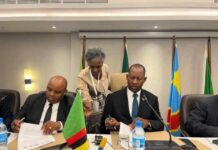The hunting and much-publicized death of Cecil the lion at the hands of a U.S. dentist has not only outraged animal rights campaigners but cast a light on the controversial and lucrative business of game hunting in Africa.
Cecil the lion, one of Zimbabwe’s most well-known animals, was killed by American dentist and hunting enthusiast, Walter Palmer, earlier this month. Palmer is believed to have paid $50,000 to shoot the animal with a bow and arrow in the country’s largest big game reserve.
Not only has Cecil’s death caused uproar around the world, it has drawn attention to the controversial business of “trophy hunting” of big game animals – some of which are endangered — in Africa.
Trophy Hunting
The hunting of wild game animals, parts of which can be kept as “souvenirs,” has its supporters and detractors.
Some analysts and wildlife organisations recognize that, when well-managed and regulated, trophy hunting can be used as a conservation tool (as recognized by organizations such as the World Wildlife Fund) as it can be closely controlled and hunting quotas regulated. It can motivate landowners to reintroduce endangered species to their land and can economically benefit local communities.
Detractors disagree, saying that trophy hunting endangers many disappearing species in certain countries, such as African lions, elephants, leopards and rhinos (all of which coveted by trophy hunters) among others, because it is so often not managed well.
U.K.-based charity, the League Against Cruel Sports, is one opponent. It said on its website that trophy hunting causes “an irreversible decline in some of the world’s most threatened species.”
According to the League’s data, since 1996, “customers of U.K. and European travel companies have slaughtered over 9,000 bears, more than 2,500 highly endangered leopards and nearly 4,000 African elephants.”
The U.K. pressure group estimated that over 560 wild lions were killed every year in Africa by international trophy hunters, with 62 percent of trophies from these kills imported into the U.S. Airlines Emirates and South African Airways have banned the transport of hunting trophies on their flights.
African governments
For African governments where trophy hunting is legal, including Zimbabwe, South Africa, Namibia, Tanzania, Botswana and Zambia, the practice can bring desperately needed money into their economies.
According to a study by the African Wildlife Conservation Fund in 2006, South Africa generated around $100 million a year from trophy hunting. More recent statistics put that figure at nearer $200 million a year.
Just a quick search of the internet shows the amounts charged for trophy hunt packages. On one site a “South African Lion hunt package” cost up to $35,000, depending on what kind of lion the hunter wanted to kill. A zebra trophy fee was far less at $1,250.
Another site was charging $24,000 in 2015 for a Lion trophy package, $42,000 for an elephant, $15,000 for a leopard and $7,450 for a crocodile.
In Zambia, for example, a ban on big cat hunting was lifted just this March and lion hunting is to be lifted next year, despite the fact that the country banned the practice in 2013 when big cat numbers were deemed too low to have a sustainable hunting industry.
When lifting the ban on leopard hunting in March, Zambia’s Tourism Minister Jean Kapata struck a different tone, saying the country had in excess of 8,000 leopards, according to an aerial survey.
“We have lifted the hunting ban for leopards starting this 2015/2016 season, which begins in July and we are going to allow lion hunting starting next year,” Kapata told Reuters.
Alluding to the dilemmas governments face over whether they can attract more money from hunting licenses from would-be hunters, or from safari tourists just wanting to observe them, Kapata said that Zambia’s trophy hunting would not be done indiscriminately as the government was mindful of the fact that many tourists visited Zambia to see the big cats.
Cecil’s revenge?
Despite the economics behind trophy-hunting, the broad public backlash against the industry has been swift and loud after the publicity of Cecil the lion’s death.
Pictures of U.S. dentist Palmer posing proudly behind the dead lion, a favorite in the Zimbabwean national park in which it lived, has prompted uproar and condemnation on social media sites around the globe this week, with #CecilTheLion trending on Twitter.
The lion is believed to have been lured outside the confines of the Hwange National Park but although that practice is not illegal in Zimbabwe, according to U.S. based charity Lion Aid, Cecil was shot in an area “not assigned a lion quota.”
Attempts were also made to destroy the lion’s collar, which had been fitted by Oxford University for a research program into conservation.
Two Zimbabwean men have been charged over the death and local police say Palmer may also face poaching charges, the BBC reported Thursday. Palmer says he believed the hunt was legal and had obtained the necessary permits for the hunt.
According to the Zimbabwe Conservation Task Force, the hunting of Cecil appeared unlawful. “Cecil, who was known all over the world would have earned millions of dollars just from sightseeing. There was apparently no quota or licence for a lion to be killed in this area,” the organization said on its website.
Charity Lion Aid believe that, ultimately, the men will not be prosecuted, however.
cnbc.com
Photo Credit – cnbc.com

 JOIN DRIVERN TAXI AS PARTNER DRIVER TODAY!
JOIN DRIVERN TAXI AS PARTNER DRIVER TODAY!












And in our country it’s a different story.